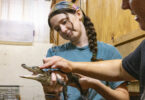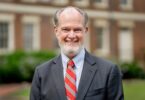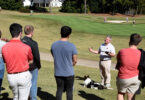Walt Disney was two men. One was a public hero, a figure who symbolized family values and squeaky cartoons; the other drank heavily and smoked cigarettes until his fingertips yellowed.
And no, he wasn’t frozen when he died.
Neal Gabler, author of Walt Disney: The Triumph of American Imagination, told stories and dispelled myths about Disney in a recent lecture sponsored by the Willson Center for Humanities and Arts and the department of theatre and film studies.
The book, an 851-page epic, has been heralded as the most thorough and complete work on Disney’s life, thanks in part to Gabler’s unfettered access to Disney archives, which Gabler likened to “getting access to the Kremlin when the Soviets ruled.”
But it was the stories he told that captured the attention of the 150-member audience at UGA.
Like his book, Gabler’s talk took a nonjudgmental view of Disney, but still managed to call him “a right-wing crazy,” “asexual” and “brilliant” in turn.
“At every story meeting, Walt had a stenographer in the room transcribing everything that was said. Then the stenographer would type up her notes and they would mimeograph them to the entire studio,” Gabler said.
“I started thinking ‘Why would they do that, when all of the principals were there?’. . . And this will tell you a little bit of the kind of man Walt Disney was; he did it because at the Walt Disney Studio, Walt Disney’s word was holy writ.”
That doesn’t mean he was always right, Gabler said. Disney’s life alternated success and failure, but rarely compromised.
After spending four years agonizing over every detail of Snow White, some of Disney’s biggest follow-up projects (Pinocchio, Fantasia) flopped, and Disney found himself financially strapped.
Disney receded from the studio after Fantasia, but continued to produce films like Dumbo that were designed expressly to make money. As Disney’s obsession moved away from animation, he grew fascinated with model trains, which ultimately led to the Disneyland (where the train is the only ride the Disney family still owns completely).
“One of the reasons he built Disneyland was because he said that when he finished the animations they were over, done with. But with Disneyland, it’s never over. It never stops; you can always keep building. And for Walt Disney that was a great thing,” Gabler said.






